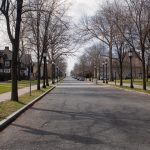By Alden R. Gordon
Professor of Fine Arts
In 1998, Trinity College’s Campus Master Plan won a national award for planning for the firm of Cooper Robertson of New York. The book that published the plan can be consulted in the Trinity College Library, Call # LD5361.T438 T7 1997. The existence of that book and of the award-winning plan was consciously ignored by the administration of former President James F. Jones Jr., who made it a policy to do the opposite of everything done by the administration of former President Evan Dobelle, under whose administration the plan was conceived. Where were the Trustees when all of this was happening, and where are they now as the current administration raises questions regarding the college’s physical plant? In 2016, leadership seems to think that connection to the city of Hartford requires a bricks and mortar presence downtown – following the lead of the University of Connecticut – rather than to our own immediate area, which we share with Hartford Hospital, the Learning Corridor and the Institute for Living. Trinity has turned its back on the Trinity College Neighborhood Plan to improve economic vitality, and it is building in such a way as to ignore its neighbors and its urban context. In so doing we have rejected our institutional history and lost our collective memory. Trinity College and its Board of Trustees have completely forgotten that it had a strategy for the future of the college in the city.
The basis of the strategy was to link the South-East quadrant of the campus (Crescent Street, the frontage on New Britain Avenue, and the area of Ferris Drive up to the Austin Arts Center and the Library) to the immediate neighborhood so as to improve the livability and commercial viability of the neighborhood and to increase the visibility of Trinity College as an institution invested in our city.
The Trinity Campus Master Plan and the Trinity College-SINA Neighborhood Commercial Development Plan (yes that also exists) envisioned a visible presence of Trinity College on New Britain Avenue, the most heavily traveled artery in our area, and a renewed Crescent Street as a major two-way southern entance to the campus. Trinity was to have an attractive and visible face to the neighborhood which would encourage small businesses to locate along New Britain Avenue and to be frequented by the Trinity and Hartford Hospital communities. Ultimately the desire was to bring into existence a “college town” along New Britain Avenue, with such services as a dry cleaner, a pharmacy, a barber shop, a beauty parlour alongside eateries, bars and other conveniences. Crescent Street and New Britain Avenue should have become a main point of entry to the campus with safe roads and walkways, good signage, landscaping, on-street parking on a two-way street giving easy access for off-campus visitors coming to Cinestudio, the Library, athletic events and campus cultural events in the Austin Arts Center.
The new, beautiful two-way Crescent Street was to make it easy for the campus safety shuttle to enter Ferris Drive from Broad Street near the field house, circulate to the East entrance to the Library (the one at the level of the Computer Center’s Service Desk in the 24 hour zone of the library) and then exit via Crescent Street to continue a circular route to Summit Street. The through linkage of Ferris Drive and Crescent Street would make it possible for visiting team busses and campus visitors to circulate easily and find a sequence of linked parking options.
All of that is now impossible because of blunders of planning committed by the Jones administration. An addition to the Austin Arts Center to the East (instead of to the North or South as called for in the plan) has now made it impossible to have access to the Library entrance or to the Library loading dock. And perhaps most egregious, a commercial-style building befitting a suburban strip mall has been built astride the right-of-way that should have been reserved for a two-way road directly extending Crescent Street to link to Ferris Drive.
The kind of services that the college had planned to move from the Student Center in Mather Hall – the bookstore and others – should have been located at the corner of New Britain Avenue and Crescent Street (where there is today a vacant surface parking lot), where travelers through Hartford would see it as a marker of Trinity College’s presence and might have actually patronized the dining options or services offered in the building.
Last week, meetings were held to invite – for the first time – input on the commercial building already constructed in the wrong place at the elbow of Crescent Street. The college is thinking of redesignating the purpose of the bulding to academic uses, which are much needed on our campus. This is an object lesson in how not to plan. Trinity will end up paying twice to plan a building that was not designed for the purposes to which it will be put.
Good planning doesn’t cost money, it saves money. Trinity is not so wealthy an institution that it can afford not to plan or to redesignate its buildings and landscape reactively. Donors do not like to give to a leadership that doesn’t know how to plan and make every donor dollar count.
Trinity should immediately reinstate a Design Review Committee consisting of Faculty and Staff, which existed until the Jones Administration dismissed it, and it should hold sessions to reintroduce the Board of Trustees and the current administration to the existence of its various Campus Master Plan components (land use, Landscape, parking, infrastructure and neighborhood economic plans).
As it now stands, the campus will be saddled for decades with the cheaply built prefab garden apartments on Crescent Street that might be appropriate in the suburbs but have no place on an a land-strapped urban campus. Does the administration and the Board have the courage to recognize their dilemma and to halt the wrongly sited Crescent Street “big box”? It is not too late to return to the Campus Master Plan and make the right moves for the Trinity Campus and to link Trinity to its neighborhood in the city of Hartford.
The author of this article is a Professor of Art History at Trinity College, was Director of the Campus Master Plan from 1996-1999, and was Editor-in-Chief of The Trinity Tripod, 1967-68.
Sunday, May 19 2024
The Student Newspaper at Trinity College in Hartford, Connecticut





+ There are no comments
Add yours